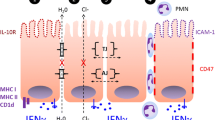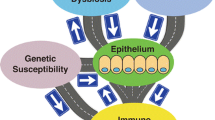Abstract
Background. Little information is available on the relative contribution of peptide growth factors and leukocyte-derived proteinases to the repair processes in inflammatory bowel disease (IBD). We investigated their possible roles in epithelial cell restitution and proliferation in patients with IBD. Methods. The expression of hepatocyte growth factor (HGF), keratinocyte growth factor (KGF), transforming growth factor-β (TGF-β), and neutrophil elastase (NE) was examined in colonic mucosal tissues. The effects of organ culture supernatants of mucosal tissues on epithelial cell restitution and proliferation were analyzed in vitro using an intestinal cell line, IEC-6 cells. Results. Most organ cultures detected the presence of measurable levels of HGF, with a relative paucity of KGF and TGF-β activity. Greater levels of HGF were obtained in the mucosa involved with IBD, especially in patients with ulcerative colitis (UC). The mucosa involved with UC also showed higher amounts of NE. The supernatants from the mucosa involved with UC possessed a prominent stimulatory effect on the restitution of IEC-6 cells. By contrast, significant suppression beyond baseline levels was observed for the proliferation of IEC-6 cells when they were incubated with recombinant HGF plus the supernatants from the mucosa involved with UC. This suppression was diminished considerably by preincubation of the supernatants with the anti-NE antibody. Conclusions. HGF produced in the intestinal mucosa may be an important stimulator acting on epithelial cell restitution in patients with IBD. However, NE released in situ may impair mucosal repair through inhibiting epithelial cell proliferation in patients with UC.
Similar content being viewed by others
References
Podolsky DK. Mucosal immunity and inflammation. V. Innate mechanisms of mucosal defense and repair: the best offense is a good defense. Am J Physiol 1999;277:G495–9.
Stenson WF. Mechanisms of tissue protection and repair in inflammatory bowel disease. Curr Opin Gastroenterol 2001;17: 313–7.
Dignass AU, Podolsky DK. Cytokine modulation of intestinal epithelial cell restitution: central role of transforming growth factor-β. Gastroenterology 1993;105:1323–32.
Beck PL, Podolsky DK. Growth factors in inflammatory bowel disease. Inflamm Bowel Dis 1999;5:44–60.
Takahashi M, Ota S, Shimada T, Hamada E, Kawabe T, Okudaira T, et al. Hepatocyte growth factor is the most potent endogenous stimulant of rabbit gastric epithelial cell proliferation and migration in primary culture. J Clin Invest 1995;95:1994–2003.
Weidner KM, Arakaki N, Hartmann G, Vandekerckhove V, Weingart S, Rieder H, et al. Evidence for the identify of human scatter factor and human hepatocyte growth factor. Proc Natl Acad Sci USA 1991;88:7001–5.
Watanabe S, Hirose M, Wang KE, Maehiro K, Murai T, Kobayashi O, et al. Hepatocyte growth factor accelerates the wound repair of cultured gastric mucosal cells. Biochem Biophys Res Commun 1994;199:1453–60.
Dignass AU, Lynch-Devaney K, Podolsky DK. Hepatocyte growth factor/scatter factor modulates intestinal epithelial cell proliferation and migration. Biochem Biophys Res Commun 1994;202:701–9.
Ciacci C, Lind SE, Podolsky DK. Transforming growth factor-β regulation of migration in wounded rat intestinal epithelial monolayers. Gastroenterology 1993;105:93–101.
Matsuno M, Shiota G, Umeki K, Kawasaki H, Kojo H, Miura K. Clinical evaluation of hepatocyte growth factor in patients with gastrointestinal and pancreatic diseases with special reference to inflammatory bowel disease. Res Commun Mol Pathol Pharmacol 1997;97:25–37.
Kitamura S, Kondo S, Shinomura Y, Isozaki K, Kanayama S, Higashimoto Y, et al. Expression of hepatocyte growth factor and c-met in ulcerative colitis. Inflamm Res 2000;49:320–4.
Finch PW, Pricolo V, Wu A, Finkelstein SD. Increased expression of keratinocyte growth factor messenger RNA associated with inflammatory bowel disease. Gastroenterology 1996;110:441–51.
Bajaj-Elliott M, Breese E, Poulsom R, Fairclough PD, MacDonald TT. Keratinocyte growth factor in inflammatory bowel disease. Increased mRNA transcripts in ulcerative colitis compared with Crohn’s disease in biopsies and isolated mucosal myofibroblasts. Am J Pathol 1997;151:1469–76.
Finch PW, Cheng AL. Analysis of the cellular basis of keratinocyte growth factor overexpression in inflammatory bowel disease. Gut 1999;45:848–55.
Babyatsky MW, Rossiter G, Podolsky DK. Expression of transforming growth factor-α and -β in colonic mucosa in inflammatory bowel disease. Gastroenterology 1996;110:975–84.
Stenson WF. Inflammatory bowel disease. In: Yamada T, Alpers DH, Laine L, Owyang C, Powell DW, editors. Textbook of gastroenterology. Philadelphia: Lippincott Williams and Wilkins
Barrick B, Campbell EJ, Owen CA. Leukocyte proteinases in wound healing: roles in physiologic and pathologic processes. Wound Repair Regen 1999;7:410–22.
Lee WL, Downey GP. Leukocyte elastase: physiological functions and role in acute lung injury. Am J Respir Crit Care Med 2001;164:896–904.
Trengove NJ, Stacey MC, MacAuley S, Bennett N, Gibson J, Burslem F, et al. Analysis of acute and chronic wound environments: the role of proteinases and their inhibitors. Wound Repair Regen 1999;7:442–52.
von Lampe B, Barthel B, Coupland SE, Riecken EO, Rosewicz S. Differential expression of matrix metalloproteinases and their tissue inhibitors in colon mucosa of patients with inflammatory bowel disease. Gut 2000;47:63–73.
Kusugami K, Fukatsu A, Tanimoto M, Shinoda M, Haruta J, Kuroiwa A, et al. Elevation of interleukin-6 in inflammatory bowel disease is macrophage- and epithelial cell-dependent. Dig Dis Sci 1995;40:949–59.
Sakai T, Kusugami K, Nishimura H, Ando T, Yamaguchi T, Ohsuga M, et al. Interleukin 15 activity in the rectal mucosa of inflammatory bowel disease. Gastroenterology 1998;114:1237–43.
Hosokawa T, Kusugami K, Ina K, Ando T, Shinoda M, Imada A, et al. Interleukin-6 and soluble interleukin-6 receptor in the co-Ionic mucosa of inflammatory bowel disease. J Gastroenterol Hepatol 1999;14:987–96.
Imada A, Ina K, Shimada M, Yokoyama T, Yokoyama Y, Nishio Y, et al. Coordinate upregulation of interleukin-8 and growth related gene product-α is present in the colonic mucosa of inflammatory bowel disease. Scand J Gastroenterol 2001;36:854–64.
Peterson GL. A simplification of the protein assay method of Lowry et al. which is more generally applicable. Anal Biochem 1977;83:346–56.
Kyokane K, Ito M, Sato Y, Ina K, Ando T, Kusugami K. Expression of Bcl-2 and p53 correlates with the morphology of gastric neoplasia. J Pathol 1998;184:382–9.
Kusugami K, Ando T, Imada A, Ina K, Ohsuga M, Shimizu T, et al. Mucosal macrophage inflammatory protein-lα activity in Helicobacter pylori infection. J Gastroenterol Hepatol 1999;14:20–6.
Nakajima K, Powers JC, Ashe BM, Zimmerman M. Mapping the extended substrate binding site of cathepsin G and human leukocyte elastase. Studies with peptide substrates related to the alpha 1-protease inhibitor reactive site. J Biol Chem 1979;254: 4027–32.
Weiss SJ. Tissue destruction by neutrophils. N Engl J Med 1989; 320:365–76.
Mitsuhashi H, Nonaka T, Hamamura I, Kishimoto T, Muratani E, Fujii K. Pharmacological activities of TEI-8362, a novel inhibitor of human neutrophil elastase. Br J Pharmacol 1999;126:1147–52.
Author information
Authors and Affiliations
Rights and permissions
About this article
Cite this article
Kuno, Y., Ina, K., Nishiwaki, T. et al. Possible involvement of neutrophil elastase in impaired mucosal repair in patients with ulcerative colitis. J Gastroenterol 37 (Suppl 14), 22–32 (2002). https://doi.org/10.1007/BF03326409
Published:
Issue Date:
DOI: https://doi.org/10.1007/BF03326409




